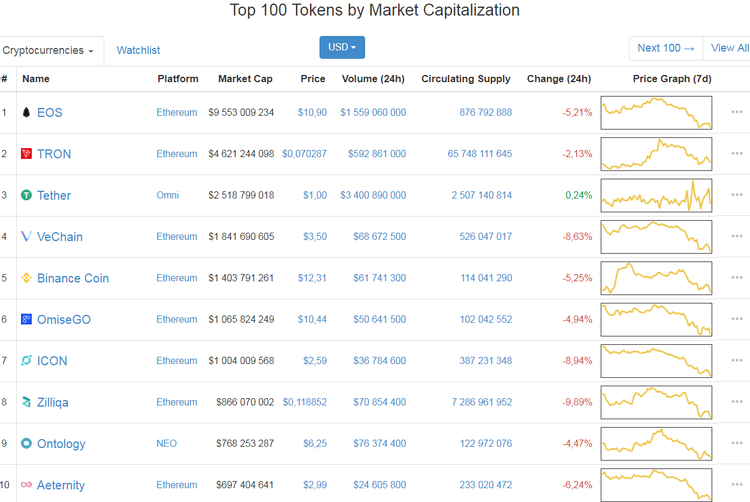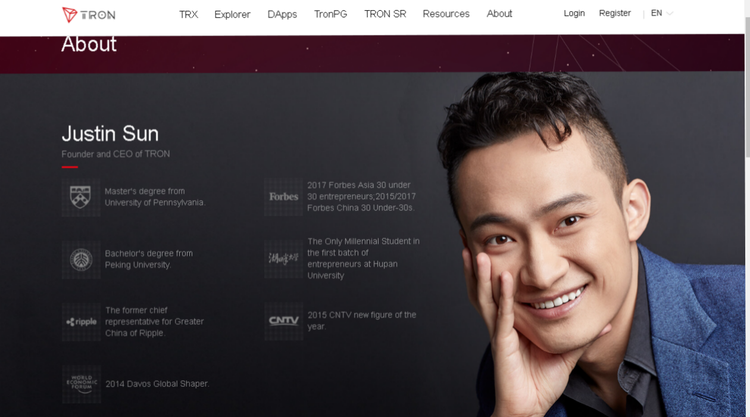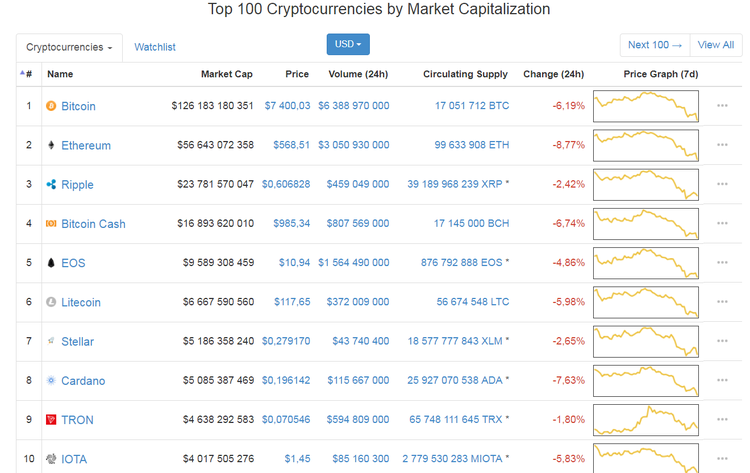TRON (TRX) is a young blockchain-based decentralized platform that aims to build a free, global digital content entertainment system with distributed storage technology.
By using features of blockchain and peer-to-peer (P2P) network technology, TRON allows content creators to connect to content consumers without having to use a middleman like Facebook, YouTube, or Amazon.
The main message of the project is that users who create data have a fundamental right to own their data, as suggested by Sir Timothy John Berners-Lee, creator of the worldwide web.
The data in TRON is uncontrollable and free, allowing users to create content, and store, download and distribute video, audio, images and characters without any restrictions.
General Overview
Tron was founded in September 2017 by the Tron Foundation, a Singapore-based non-profit.
The platform describes itself as an “ambitious project dedicated to the establishment of a truly decentralized Internet and its infrastructure.”
According to the TRON whitepaper, the protocol allows each user to publish, store and own data freely in a decentralized, autonomous form, in addition to decide the distribution, subscription, and push of content that enables content creators to form a decentralized content entertainment ecosystem.”
TRON has an official token, ranked second in the world with a total market cap of $4.5 billion, according to CoinMarketCap.com.
The Team
The CEO of the Tron Foundation is Justin Sun, who is also the founder of Peiwo, the first live streaming app to receive cryptos. Sun previously worked for another fledgling cryptocurrency - Ripple (XRP).
The current Tron team radiates out from Beijing to Seoul, Tokyo, the United States and many other countries and regions, totaling more than 100 members. Experienced blockchain enthusiasts who were previously employed by internet giants such as Alibaba, Tencent and Baidu, make up Tron’s technological backbone.
Tron Foundation’s establishment was approved by Singapore’s Accounting and Corporate Regulatory Authority (ACRA), and is supervised by Singapore’s corporate law.
TRON receives investments from Bitmain, Qtum Foundation, FBG Capital, the Founder of OFO Dai Wei, among others.
TRON, the currency of Tron
In September 2017 Tron completed its global fundraising campaign, raising a total of $70 000 000. In December of the same year, Tron launched its open source protocol.
Tron and its native coin TRON (TRX) have had a rollercoaster ride since the ICO. TRX rose from $0.0015 to a high of $0.30 on January 2018, before falling back down to its current price of $0.07.
TRON (TRX) is the basic unit of account on the Tron platform - it can be used by content consumers to pay for the content they want to access.
In order to secure the token holder’s rights, Tron formulated a set of regulations - the Tron Community Guidelines - to create a level playing field for all the platform’s users.
The project’s team pays special attention to users’ security - the platform’s transaction model improves on the one employed by Bitcoin. Just like any other digital asset, Tron can potentially be compromised. Basic security techniques - like securing private keys by using hardware wallets - still need to be followed to increase the chance of protecting one’s assets.
In May 2018, TRON was ranked 9th on the list of largest cryptocurrencies by market capitalization.
Where to Buy and Save
TRON’s token is traded on all major crypto exchanges - Binance, Bittrex, Upbit, Bitfinex, HuobiPro, Coinnest, OKEX, and others - for other cryptocurrencies like ETH or BTC. Purchase with fiat currencies is not possible at the moment.
TRON is an ERC-20 token, so users can store it on hardware wallets that support the Ethereum blockchain such as Ledger Nano S and Trezor.
TRON Mainnet to Launch in May
Despite it being ranked in the cryptocurrency top-10, the actual TRON network has not yet launched - Tron is currently structured as an ERC-20 token.
TRON mainnet is scheduled to launch on May 31, 2018.
The mainnet, which launches in May, will possess all high priority functions - less important features will be deployed later in the form of version upgrades. By the end of 2018, TRON’s mainnet is expected to host tens of millions of active users and over a million token holders.
The platform’s wallet will be released alongside the mainnet, and more partnerships will be announced in the future, according to recent comments from Justin Sun.
TRON has the potential to become one of the top blockchain platforms in 2018, as more and more companies can create DApps on the TRON mainnet, Tron Labs wrote in a blog post.
Moreover, the Tron team is planning a token migration on June 21, 2018. Several digital asset trading platforms, such as Bitfinex, have announced their support for TRON’s mainnet update and token migration.
TRON vs. Ethereum
With the mainnet launch expected in May, Tron plans to shed its ERC-20 identity and migrate from the Ethereum platform. Once the mainnet goes live, Tron will no longer be an ERC-20 token, become a “true” token within the Tron ecosystem.
Ethereum launched in late July 2015 and opened the door to Blockchain 2.0. TRON has had its sights set on creating Blockchain 4.0 since its initial stages, potentially making it one of the biggest challengers Ethereum will face in the near future.
TRON is committed to creating a decentralized smart contract platform with higher throughput, extension, and reliability capabilities than Ethereum.
Ethereum initially used Ethash, a PoW-based, variant consensus algorithm. Even though the algorithm was improved, it may require a long period of testing. Meanwhile, TRON employs an optimized "Delegated Proof of Stake" (DPoS) consensus system, which uses a witness mechanism to achieve decentralization, where delegate nodes are selected by the blockchain network community through voting. TRON may outperform Ethereum by utilizing a new generation consensus system.
Ethereum supports the development of smart contracts via advanced, turing-complete language, and has already designed a programming language called Solidity to write smart contracts. Tron will also have its own TVM with fast loading speeds, resource isolation, and scalability. The p protocol is defined completely by Google protobuf and will naturally support multi-language expansion. TRON's smart contract is much more flexible and easy to use than Ethereum's.
Ethereum’s consensus mechanism is inefficient and limited by CPU single-thread performance issues. Under TRON's excellent consensus system, users select maintenance nodes from a limited number of nodes with high computational performance. The company's network can dynamically adjust bookkeeper sets based on block generation speeds and delays. If one is to judge by performance and throughput, Tron appears to come out on top.
Ethereum uses a leasing model that controls the execution command cap for a certain transaction through Gas. There will be many fees involved with high volatility. TRON also uses a leasing model but improved on the economic mechanism by supporting free transfers.
Relationship with Alibaba
According to Forbes, Justin Sun is the protege of Jack Ma, founder and CEO chairman of Alibaba.
Sun graduated from the Alibaba CEO’s alma mater, Hupan University, earlier this year, an Ambcrypto report said. Towards the end of March, Sun submitted a thesis titled “The Birth of a Decentralized Internet” providing detailed opinions on the blockchain industry’s history, present and future.
This relationship begs the question of whether the two entities will converge in the future. No statements have yet been made, leaving the market.
Future Plans
Tron has lined up lots of potential milestones in the years to come, Investopedia reports.
Exodus, its current offering, is a free platform suitable for peer-to-peer (P2P) distribution and content storage. Exodus doesn’t yet employ blockchain technology, using a special web-based file system protocol that supports a distributed file system. This phase is expected to maintain through December 2018.
The next phase, called Odyssey, is scheduled to go live around January 2019. Odyssey, which will leverage the power of blockchain, will involve monetary incentives to promote the creation and hosting of content on Tron.
Instead of following traditional ways of tracking clicks and content views, Odyssey plans to base incentive producers on a method that will depend on user interaction and content engagement. This may be linked to a “tipping” plan – something like a reward based on how well the content was perceived by the user.
The next two phases - Great Voyage (mid-2020) and Apollo (mid-2021) - are expected to enable content creators to build their own personal brands, get the ability to carry out ICOs, and even issue personal tokens.
TRON also expects two more stages further down the line, called Star Trek (mid-2023) and Eternity (late 2025), where participants will be able to create their own decentralized gaming and predictive markets platforms, and will also be able to raise funds.
Fake News
Rumors have circulated that Justin Sun dumped 6 billion TRON at the token’s all-time high, but an independent investigation found this to be false. Scammers also managed to verify a fake Justin Sun Twitter account. When Sun’s official profile announced the TRON Test Net Launch by starting a countdown of the number of days left, the fake account exploited the tweet in the comments section.
Justin Sun’s official Twitter account announced on March 23:
#TRON Test Net Launch Countdown: 20 days, 483 hours, 29,000 minutes, 1,740,000 seconds. #TRON #TRX $TRX
— Justin Sun (@justinsuntron) March 11, 2018
On which the fake account commented:
“Tron Foundation’s Twitter account was in the limelight when a huge scam took place on this social media platform”.
The scammers later used a different username to create a fake Tron Foundation account, claiming that ‘they woulf provide all TRON users with double the ETH sent to their account’. Quite a few users fell for the ploy, as the profile was verified by Twitter.
Vitalik Buterin, the founder of Ethereum, recently started a Twitter movement to increase awareness of fraud by changing his profile name to “Vitalik ‘No I’m not giving away ETH’ Buterin”. CZ, the CEO of Binance, followed Buterin’s lead and changed his profile name to ”CZ (not giving crypto away).”
By Yana Sheremetyeva






